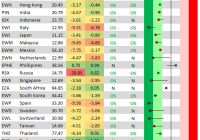Chile As A Proxy For Copper
Summary Copper has fallen a great deal in recent months, which means a bounce in prices is likely. Copper is extremely important to Chile’s economy, which makes it very vulnerable whenever prices go down. Chile will most likely remain weak in the near future even if copper prices recover somewhat. Prices in the commodity sector have certainly been on the decline. Of all the commodities that have seen prices go down, one of the worst affected has to be copper (NYSEARCA: JJC ). Copper has in fact been on the decline the last four years and is now down roughly 60 percent from its highs in 2011. This decline has even accelerated the last six months with prices down by a third. The two charts below show how copper has behaved the last five years and the last 12 months: Such a big decline of more than 30 percent in such a short amount of time increases the odds of a bounce in copper prices. Copper is very much oversold, and there is a good chance that prices should go up somewhat at these levels. Those who are still negative on copper may therefore be interested in an alternative, and that alternative can be found in the country of Chile. Why Chile can be considered a proxy for copper Chile is by far the biggest producer and exporter of copper. For the whole of 2014, statistics show that Chile contributed 5.8 million metric tons of copper with global production at 18.7 million metric tons. Copper makes up almost half of Chile’s total exports, making its economy highly dependent on whatever happens to copper. If copper prices go down as they have been in recent times, Chile is bound to feel the effects. Economic indicators suggest that Chile is getting weaker as copper prices are sliding. For instance, exports have been shrinking, led by the decline in copper prices, as the chart below indicates. Both the government budget and the trade balance are now in a deficit, which seems to be getting bigger as time goes by. A sharp reversal from the sizable surpluses seen in recent years: (click to enlarge) Overall, growth in Gross Domestic Product (“GDP”) is slowing down, and the economy is struggling to avoid falling into a recession. The weakness in Chile’s economy is best reflected in the exchange rate between Chile’s domestic currency, the peso, and the U.S. dollar. The peso has already lost 17.5 percent of its value in 2015 and further devaluations are very likely, if not necessary, versus the U.S. dollar. The current trend certainly does not look good for Chile. (click to enlarge) Copper prospects While copper prices may witness a bounce in the short term, if only because of oversold conditions, a return to recent highs is highly unlikely. The strong growth of copper in recent years was primarily driven by China, which now accounts for almost half of the global consumption of copper. However, growth in demand for copper in China seems to be moderating and is now only in the low-single digits. Demand for copper outside of China is much weaker. The International Copper Study Group (“ICSG”) forecasts a flat market for copper with supply and demand evenly balanced. Much will depend on what happens in China or its economy, but there isn’t much demand for copper globally once you ignore China. There’s the possibility that there may be a slight deficit in copper supplies next year, especially if companies cut production more than expected, but nowhere near the levels seen in previous years. This should help keep a lid on copper prices, which is not good news for Chile. Chile relative to copper Since copper is oversold as a commodity, it’s realistic to expect a bounce in prices in the not-too-distant future. Initiating new shorts at these levels is therefore not recommended, at least for now. Those who are still negative when it comes to copper may instead want to look at Chile as an alternative or a proxy to copper. Exposure to Chile can be had through, for instance, ETFs such as the iShares MSCI Chile Capped ETF (NYSEARCA: ECH ). Chile could also serve as a hedge for any long or short positions in copper. For instance, a long position in Chile to offset a short position in copper or vice versa. This will remain the case for as long as Chile’s economy is heavily dependent on the export of copper and it does not diversify its economic base. The fact is that Chile is overly exposed to the prospects of a single commodity (“copper”), which in turn is highly dependent on the prospects of a single country (“China”). If copper prices go up by a lot, it’s boom time for Chile. But, if copper prices go down, Chile’s economy will get weaker. Not a very healthy situation to be in. The bottom line is that even if copper prices were to increase somewhat in the future, Chile will still not experience the windfall it received in previous years. For that to happen, copper would have to return to the very high prices of several years ago. A very unlikely prospect. Chile can be expected to remain relatively weak even if copper experiences a bounce in prices.
